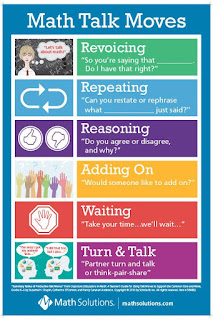At Twitter Math Camp (TMC) this year I attended a morning session entitled Rich Tasks Demand Rich Implementation to Maximize Student Learning presented by Peg Cagle, Cal Armstrong, and Bill Thill. In at least one of the two hour sessions the book 5 Practices for Orchestrating Productive Mathematics Discussions was mentioned as a good resource for preparing rich task lessons. The paragraph at the top of this post appears in the first paragraph of the introduction to this book and helps describe my #1TMCthing. My #1TMCthing this year is to incorporate more rich tasks in the courses I teach, starting specifically with geometry. But, as Peg mentioned in her session, activities and tasks should be aligned to curricular goals and will further the mathematical learning of the students, not be used just for the sake of "Oh, this looks cool!" (I am afraid I've been guilty of this in the past. )
So, I set a goal for myself in the remaining two weeks before school starts to read two books: 5 Practices and Putting Essential Understanding of Geometry into Practices in Grades 9-12. So far I've managed to complete the former. The 5 Practices described in the book are:
- Anticipate likely student responses to challenging math tasks.
- Monitor students' actual responses to the task while students work in pairs or small groups.
- Select particular students to present their mathematical work on the task in discussion.
- Sequence the student responses that will be displayed in a specific order
- Connect different students' responses and connect their responses to key mathematical ideas.
Here's what I've gleaned as a simple planning process:
- The first step is to determine what curricular goal you're trying to meet and identify what methods could best meet these goals. Not every lesson is going to be a task or activity. Some will still be worksheets and teacher led notes. That being said, the questions posed to the class should still further their thinking. The 5 Practices process described in the next steps only apply to rich task implementation.
- Next, use a Thinking Through a Lesson Protocol template (a multitude of which can be found through a Google search) to guide the planning process. This template should guide you through the planning portion of the 5 Practices: anticipating, selecting, sequencing, and collecting, as well as help you identify what materials the lesson will require, etc.
- Create a monitoring sheet to be used during the lesson. This sheet should a column listing the anticipated solution processes made in the planning phase, a column to record which student(s) have employed each solution process, and a column in which the teacher will make notes regarding the sequencing of the solution processes. Rows can be added to the table for the teacher to record processes that were not anticipated or that highlight student errors.
- During the lesson, make use of a variety of questioning techniques that encourage all students to participate and help students connect the various representations and how they connect to the mathematical goal. Use questions and statements similar to those shown below in the Math Talk Moves.
- After the lesson, review what happened. What went well? Did students struggle with any particular concepts or representations? Are more days needed to complete the lesson? Make notes on the lesson template that will help you when you implement this lesson in future years. It may be useful to update the monitoring sheet, if needed, at this time.
The bits of information that I have listed above in no way fully describe the wealth of information that can be found in this text. The authors include more details about each of the 5 Practices and how to ask good questions that will make the learning more student centered. It is my hope, though, that I can use this process to increase the number of tasks that I use and improve their effectiveness on student learning. A thread on the MTBoS forum as been started related to rich tasks for geometry. If you have any tasks you've used that you feel are worth sharing, please add them to that thread.
An aside...
Join the #MTBoS blogging group by participating in #SundayFunday. More information about it can be found here: Let's Blog Together! Sunday Funday is back!


No comments:
Post a Comment